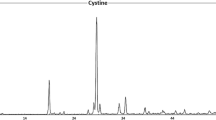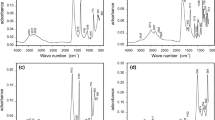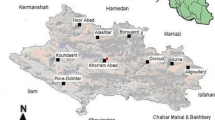Abstract
Urinary stone diseases are increasing in the Middle East. The majority of urinary stone cases are found in the northern part of the country. Stone samples taken from patients living in the Irbid area were collected from Princess Basma Hospital. The present study concentrates on the mineralogical and chemical composition of the urinary stones and on the effective environmental factors that assist in developing the different types of urinary stones. Using X-ray diffraction techniques, the mineralogical composition of the urinary stones was found to be as follows: oxalate, cholesten, and uric acid, with cystine stones occuring more frequently than the others. Cholesten and calcium oxalate stones are the most dominant types of stones. Calcium oxalate is the most common type of oxalate stone. Calcium oxalate is represented in: whewellite, wheddellite, and calcium carbonate oxalate hydrate minerals, in addition to other minerals such as brushite, ammonium phosphate, vaterite, valleriite, and bobierrite from other types of stones. Bobierrite (phosphate group) is a new mineral reported in urinary stones, and this has not been determined in any previous study worldwide. Apatite (calcium phosphate) is deduced using scanning electron microscope (SEM) images. The SEM technique determined crystal forms and systems, shapes, morphological features, and the names of the minerals forming urine stones, while optical properties are studied by polarizing microscope. X-ray fluorescence technique determined the concentrations of major and some trace elements. It revealed that Ca is the main constituent of the urinary stones, especially those composed of calcium oxalate and calcium phosphate. The concentration of trace elements was Ba = 1.57, P = 3.61, Fe = 1.78, S = 2.08, Zr = 4.63, Mo = 3.92, Cu = 1.89, Co = 1.56, and F = 4.2% and was higher in the urinary stones of Jordanian patients than in foreigners in the country. Questionnaires completed by patients suggest that the most significant factors directly effecting the formation of stones are water, climate conditions, food rich in protein and rich in different chemicals. Moreover, some drugs and diseases might also help in developing other stones.
















Similar content being viewed by others
References
Abboud, I. A. (2006). Water quality of Irbid City, Jordan. Al al-Bayt University Projects. Result work under proposing.
Abdel-Halim, R. E., Al-Sibaai, A., & Baghlff, A. O. (1993). Ionic associations within 460 non infection urinary stones. Scandinavian Journal of Urology Nephrology, 27, 155–162.
Abu-Farsakh, F. (1997). Correlation between copper, zinc and some lipids in serum, bile and stones of patients with gall stone disease. Dirasat Medical and Biological Sciences, 24(1), 54–59.
Al-Fawaaz, M. M. (2006). Diagnostic of environmental effects in stone formation and traces on human health—Northeastern of Jordan, Study in medical geochemistry. M.Sc. Thesis, Al al-Bayt University, Jordan, p. 124.
Al-Maliki, M. A. (1998). Renal stones a study in medical geochemistry. M.Sc. Thesis, Baghdad University, p. 101.
Al-Naam, L. M., Baqir, Y., Rasoul, H., Susan, L. P., & Alkhaddar, M. (1987). The incidence and composition of urinary stones in southern Iraq. Saudi Medical Journal, 8, 456–461.
Anderson, D. A. (1969). Historical and geographical differences in the pattern of incidence of urinary stones considered in possible relation to aetiological factors. In A. Hodgkinson & B. E. C. Nordin (Eds.), Renal stones research symposium (pp. 7–31). London: Churchill.
Andrew, J. P., & Chandru, P. S., (2001). Diagnosis and initial management of kidney stones. American Family Physician, http://www.aatp.org/atp/20010401/1329.html. p. 17.
Aziz, A. A., Abboud, M. M., Asker, F., & Al-Kadi, A. (1985). Metabolic studies or renal stone disease in Iraq. Journal of the Faculty of Medicine Baghdad, 27(1), 11–18.
Benton, D., et al. (1997). The vitamin status of young British adults. International Journal of Nutrition Research, 67, 34–40.
Curhan, G. C., Willett, W. C., Rimm, E. B., & Stampfer, M. J. (1993). A prospective study of dietary calcium and other nutrients and the risk of symptomatic kidney stones. The New England Journal of Medicine, 328, 833–838.
Dajani, A., Abu Khadra, A., & Baghdadi, F. (1988). Urolithiasis in Jordanian children. A report of 52 cases. British Journal of Urology, 61, 482–486.
Dajani, A., Bjornesjo, K., & Shehabi, A. (1981). Urinary stone disease in Jordan. In J. G. Brockis & Finlayson, B. (Eds.), Urinary calculus (pp. 35–45). Littleton: PSG Publishing Co.
Deeming, S. P., & Wepu, C. W. (1977). Evaluation of hair analysis for determination of zinc status using rats. American Journal of Clinical Nutrition, 30, 2047–2052.
Evenson, M. A., & Warren, B. L. (1975). Determination of copper by atomic absorption, with use of the graphic Cuvette. Clinical Chemistry, 21, 619–625.
Fellstrom, B., Danielson, B. G., Karlstrom, B., Lithell, H., Lunghall, S., Vessby, B., & Wide, L. (1986a). Effects of high intake of dietary animal protein on mineral metabolism and urinary super saturation of calcium oxalate in renal stone formers. British Journal of Urology, 56, 263–269.
Fellstrom, B., Danielson, B. G., Ljunghall, S., & Wikstrom, B. (1986b). Crystal inhibition. The effects of polyanions on calcium oxalate crystals growth. Clinica Chimica Acta, 158, 213–230.
Finlayson, B. (1974). Symposium on renal lithiasis. Renal Lithiasis in review. The Urologic Clinics of North America, 1, 181–212.
Foote, J. W., & Delves, H. T. (1982). Determination of zinc in small volumes of serum using absorption spectrophotometry with electrothermal atomization. The Analyst, 107, 1729–1734.
Freundlich, E., Saab, K., & Bitterman, W. (1982). Urinary calculi in children. Urology, 20, 503–505.
Fru, F., Angwafo, III., Samuel, T., & Donald, G. (2004). Determination of chemical composition of gall bladder stones: Basis for treatment strategies in patients from Yaounde, Cameroon. World Journal of Gastroenterology, 10(2), 303–305.
Gentle, D., Stoller, M., Bruce, J., & Leslie, S. (1997). Geriatric urolithiasis. Journal Urology, 158, 2221–2224.
Grases, F., Geider, S., Dussol, B., et al. (1990). Nucleation of calcium oxalate crystals aggregation. British Journal of Urology, 66, 240–244.
Gupta, N. P., Kochar, G. S., Wadhwa, S. N., & Sigh, S. M. (1985). Management of patients with renal and ureteric calculi presenting with chronic renal insufficiency. British Journal of Urology, 57, 130–132.
Halzbach, R. T., March, M., & Olszewski, M. (1973). Cholesterol solubility in bile. Evidence that supersaturated bile is frequent in healthy man. Journal of Clinical Investigations, 52, 1467–1479.
Hammoud, A. F., El-AsSkary, M. A., Badt, M., & Ibrahim, F. (1973). Mineralogical composition of Egyptian urinary calculi. Tanta Medicine of Journal, 1, 1–27.
Hassan, S., & Dabbagh, T. (1988). Chemical composition of urinary stone’s nuclei and its pathogenetic significance in stone disease initiation. Journal of the Faculty of Medicine Baghdad, 30(2), 191–199.
Hesse, A., Berg, W., Schneider, H. J., et al. (1976). A contribution to the formation mechanism of calcium oxalate urinary calculi II. Urological Research, 4,157–160.
Hodgkinson, A. (1977). Composition of urinary tract calculi in children of different ages. British Journal of Urology, 49, 453–455.
Hodgkinson, A., & Marshall, R. W. (1975). Changes in the composition of urinary tract stones. Investigative Urology, 13, 131–137.
Husain, M., Lal, M., Ali, B., et al. (1995). Management of urinary calculi associated with renal failure. The Journal of the Pakistan Medical Association, 45, 205–208.
Hussein, M., Al-Manee, M. S., Dhar, R., Abu-Farsakh, F. A., & Mousa, A. M. (1989). The pattern of gall bladder disease in the Al-Adan area. The Journal of the Kuwait Medical Association, 23(3), 256–260.
Joost, J., & Tessadri, R. (1983). Combined analysis of kidney stones by X-ray diffraction and electron microprobe. European Urology, 9, 305–311.
Lee, Y.-H., Huang, W.-C., Chiang, H., Chen, M.-T., Huang, J.-K., & Chang, L. S. (1992). Determinate role of testosterone in the pathogenesis of urolithiasis in rats. Journal of Urology, 147, 1134–1138.
Leusmann, D. B. (1981). Erste zusammenfassende Ergebnisse der kombinierten Phasen- und Gefugeanalyse von Harnsteinen mittels Rontgenbeugung und Rasterelektronenmikroskopie. Fortschritte der Urology and Nephrology, 17, 275–305.
Martin, X., Smith, L. H., & Werness, P. G. (1992). Calcium oxalate dehydrate formation in urine. Kidney International, 25, 948–952.
Mena, J., et al. (1969). Chronic manganese poisoning. Neurology, 19, 1000–1006.
Meranger, J. C., & Smith, D. C. (1972). The heavy metals content of a typical Canadian diet. Canadian Journal of Public Health, 63, 53–57.
Mhelan, M. M. (1992). The management and treatment of 400 patients with urolithiasis. Dirasat Journal, V19(B), No. 4.
Nakai, K., Tazuma, S., Ochi, H., & Chayama, K. (2001). Does bilirubin play a role in the pathogenesis of both cholesterol and pigment gall stone formation? Direct and indirect influences on bilirubin on bile lithogenicity. Biochimica et Biophysica Acta, 1534, 78–84.
Oka, T., Hara, T., Miyake, O., et al. (1989). A study on bacteria within stones in urolithiasis. Hinyokika Kiyo, 35, 1469–1474.
Park, S. J. H., & Coe, F. L. (1994). A increasing number of calcium oxalate stone events worsens treatment out com. Kidney International, 45, 1722–1730.
Pierratos, A. E., Khalaff, P. T., Cheng, K., Pshramis, K., & Jewettm, A. S. (1994). Clinical and biochemical differences in patients with pure calcium oxalate monohydrate and calcium oxalate dihydrate kidney stones. Journal of Urology, 151, 571–574.
Prien, E. L., & Frondel, C. (1947). Studies in urolithiasis. I. The composition of urinary calculi. Journal of Urology, 57, 949–991.
Sjovall, A. (1986). Urinary tract disease in the United Arab Emirates: A radiological study. Saudi Medical Journal, 7, 143–148.
Sobhi, N. (2006). The mineralogy and chemistry of urinary stones from the Arabian Gulf. Internet site, work not published., Result work under proposing, p. 8.
Remzi, D. (1980). Urolithiasis in infancy. Urology, 15, 248–250.
Remzi, D., Bakkaloglu, M., Erkan, I., et al. (1984). Pediatric urolithiasis. The Turkish Journal of Pediatrics, 26, 43–49.
Rizvi, S. A. H., Naqvi, S. A. A., Hussain, Z., Hashmi, A., Hussain, M., Zafar, M. N., Mehdi, H., & Khalid, R. (2002). The management of stone disease. BJU International, 98(Suppl. 1), 62–68.
Robertson, W. G., & Peacock, M. (1982). The pattern of urinary stone disease in Leeds and in the United Kingdom in relation to animal protein intake during the period 1960–1980. Urology International, 73, 394–399.
Robertson, W. G., Peacock, M., Heyburn, P., & Hanes, F., (1980). Epidemionological risk factors in calcium stone disease. Scandinavian Journal of Urology and Nephrology, 53, 15–28.
Robertson, W. G., Peacock, M., Heyburn, P. J., Marshall, D. H., & Clark, P. B. (1978). Risk factors in calcium stone disease of the urinary tract. British Journal of Urology, 50, 449–454.
Ros, E., Navarro, S., Fernadez, I., Reixach, M., Ribo, Mj., & Rodes, J. (1986). Utility of biliary microscopy for the prediction of the chemical composition of gall stones and outcome of dissolution therapy with ursodexycholic acid. Gastroenterology, 91, 703–712.
Tellaloglu, S., & Ander, H. (1984). Stones in children. The Turkish Journal of Pediatrics, 26, 51–56.
Yagisawa, T., Hayashi, T., Yoshida, A., Okuda, H., Kobayashi, H., Ishikawa, N., Goya, N., & Toma, H. (1999). Metabolic characteristics of the elderly with recurrent calcium oxalate stones. BJU International, 83, 924–928.
Electronic references
http://www.Metrogi.com/pdf_docs/Info_Gallstones.pdf±gallbladder±stones±,cholesterol&hl=en&ie=UTF; Encyclopedia Britannica Article. 2005; p. 4.
Kidney stone (2005). Encyclopedia Britannica. 2004. Encyclopedia Britannica Premium Service. http://www.britannica.com/eb/article?tocId=9045395. p. 4.
Acknowledgments
This research was sponsored by a grant from Al al-Bayt University. The author highly appreciates the efforts of Professor Dr. Nadher Al Ansari, Dr. Ali Ahmed Bani Nasser and Mr. Musa Al-Zghoul during all stages of this research.
Author information
Authors and Affiliations
Corresponding author
Rights and permissions
About this article
Cite this article
Abboud, I.A. Mineralogy and chemistry of urinary stones: patients from North Jordan. Environ Geochem Health 30, 445–463 (2008). https://doi.org/10.1007/s10653-007-9128-7
Received:
Accepted:
Published:
Issue Date:
DOI: https://doi.org/10.1007/s10653-007-9128-7




